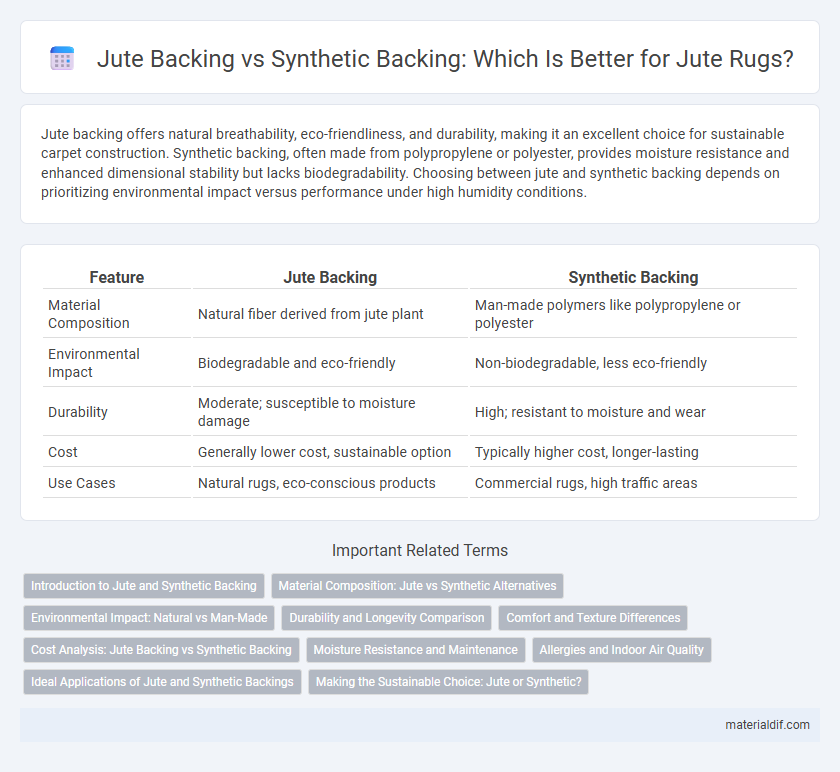Jute backing offers natural breathability, eco-friendliness, and durability, making it an excellent choice for sustainable carpet construction. Synthetic backing, often made from polypropylene or polyester, provides moisture resistance and enhanced dimensional stability but lacks biodegradability. Choosing between jute and synthetic backing depends on prioritizing environmental impact versus performance under high humidity conditions.
Table of Comparison
| Feature | Jute Backing | Synthetic Backing |
|---|---|---|
| Material Composition | Natural fiber derived from jute plant | Man-made polymers like polypropylene or polyester |
| Environmental Impact | Biodegradable and eco-friendly | Non-biodegradable, less eco-friendly |
| Durability | Moderate; susceptible to moisture damage | High; resistant to moisture and wear |
| Cost | Generally lower cost, sustainable option | Typically higher cost, longer-lasting |
| Use Cases | Natural rugs, eco-conscious products | Commercial rugs, high traffic areas |
Introduction to Jute and Synthetic Backing
Jute backing is a natural fiber derived from the jute plant, known for its biodegradability and eco-friendly properties, making it a sustainable choice in carpet manufacturing. Synthetic backing, typically made from materials like polypropylene or polyester, offers enhanced durability, moisture resistance, and cost-effectiveness. The choice between jute and synthetic backing depends on factors like environmental impact, longevity, and performance requirements in various flooring applications.
Material Composition: Jute vs Synthetic Alternatives
Jute backing is composed of natural fibers derived from the jute plant, offering biodegradability and breathability that enhance carpet durability and environmental sustainability. Synthetic backing materials, such as polypropylene or polyester, are petroleum-based, providing increased moisture resistance and dimensional stability but lacking the eco-friendly benefits of jute. The choice between jute and synthetic backing hinges on balancing natural fiber advantages with the performance characteristics required for specific flooring applications.
Environmental Impact: Natural vs Man-Made
Jute backing, derived from natural plant fibers, is biodegradable and compostable, significantly reducing landfill waste and carbon footprint compared to synthetic backing made from petroleum-based materials. Synthetic backing often contains non-biodegradable plastics that persist for decades in the environment, contributing to microplastic pollution and resource depletion. Choosing jute backing supports sustainable agriculture and promotes eco-friendly disposal practices, aligning with green building standards.
Durability and Longevity Comparison
Jute backing offers natural breathability and biodegradability but tends to absorb moisture, leading to reduced durability and a shorter lifespan compared to synthetic backing. Synthetic backing materials, such as polypropylene or polyester, provide enhanced resistance to wear, moisture, and staining, significantly extending the carpet's longevity in high-traffic areas. Overall, synthetic backing ensures superior performance and durability, making it ideal for environments demanding long-lasting flooring solutions.
Comfort and Texture Differences
Jute backing offers a natural, breathable texture that enhances comfort by allowing better air circulation and providing a soft, cushioned feel underfoot. Synthetic backing, often made from materials like polypropylene, tends to be less breathable and firmer, which can result in a less comfortable surface. Jute's organic fibers create a warm, textured aesthetic, whereas synthetic backing typically feels smoother and more uniform but lacks the natural resilience of jute.
Cost Analysis: Jute Backing vs Synthetic Backing
Jute backing is generally more cost-effective than synthetic backing due to its natural fiber composition, lower production expenses, and biodegradability, which reduces disposal costs. Synthetic backing often involves higher material and manufacturing costs, but it offers durability and moisture resistance that can lower long-term maintenance expenses. Evaluating total cost of ownership, jute backing presents initial cost savings, while synthetic backing may provide financial benefits through extended lifespan in high-moisture environments.
Moisture Resistance and Maintenance
Jute backing offers natural breathability but tends to absorb moisture, making it prone to mold and mildew in humid environments. Synthetic backing, such as polypropylene or latex, provides superior moisture resistance and prevents water damage, reducing the risk of mold growth. Maintenance for synthetic-backed rugs is easier as they dry quickly and require less frequent cleaning compared to moisture-sensitive jute backing.
Allergies and Indoor Air Quality
Jute backing is a natural fiber that significantly reduces the risk of allergic reactions and enhances indoor air quality by minimizing the release of volatile organic compounds (VOCs) often found in synthetic materials. Unlike synthetic backings, jute is biodegradable and breathable, which helps regulate humidity and prevents mold growth, further improving air quality. Choosing jute backing for carpets supports a healthier living environment by reducing exposure to allergens and chemical irritants common with synthetic alternatives.
Ideal Applications of Jute and Synthetic Backings
Jute backing is ideal for natural fiber rugs and traditional carpet styles, offering breathability and eco-friendliness, making it suitable for low-traffic areas and indoor spaces that emphasize sustainability. Synthetic backing excels in high-moisture environments, commercial settings, and outdoor applications due to its moisture resistance, durability, and ease of maintenance. Choosing between jute and synthetic backing depends on the specific use case, with jute preferred for aesthetics and environmental benefits, and synthetic backing favored for performance and longevity.
Making the Sustainable Choice: Jute or Synthetic?
Jute backing offers a biodegradable, eco-friendly option for carpets, promoting sustainability through natural fibers that decompose without harming the environment. Synthetic backing, made from petroleum-based materials, provides durability and moisture resistance but contributes to plastic waste and environmental degradation. Choosing jute backing supports renewable resources and reduces carbon footprint, making it the more sustainable choice compared to synthetic alternatives.
Jute Backing vs Synthetic Backing Infographic

 materialdif.com
materialdif.com